Mud doesn’t stop us or a hike along the Kungurberat tract, Uzbekistan

Hello, today I would like to tell you about my trip to the Kungurberat tract, which is located in the Tashkent region. The trip took place on March 21 - the day of celebration of Navruz - the holiday of the arrival of spring according to the astronomical solar calendar among the Iranian and Turkic peoples. Usually on this day (or rather, the day before Navruz), a traditional treat of sprouted wheat grains - sumalak is cooked. Quite a tasty dish, but it was on this day that we did not manage to taste it. At that time we were beating mud a hundred kilometers far from Tashkent.
There are a couple of special places for me in the Tashkent region. The first is the unattainable Institute of the Sun in the village of Kumyshkan. I climbed all the nearby locations, but I was not able to visit the institute itself.
The second location is Mount Syurenata and its surroundings. I've been to these places five or six times already. I walked around the mountain from almost all sides. So this time our path ran in the vicinity of Syurenata.
Spring was rainy this year. And on the eve of the trip, it also rained, and in the morning in Tashkent it was a little cloudy. Moreover, when we left the city, we got into a strip of fog. I was a little upset, because I was afraid that the weather would be cloudy and foggy, and then my photos will be so dark. I already had the experience of wandering in the fog, and just in these places. Basically, foggy hikes have their own beauty of course, but I more like clear weather ...

The heavens, apparently, took pity on me and when we approached the starting point of our trip, the sky cleared, leaving only clouds that were especially beautiful in the rays of the rising sun.


We walked around the hill and began to climb the path upward. The higher we climbed, the more picturesque views opened up in front of us.



Turning again, I saw Syurenata. From this angle, it was somewhat reminiscent of the famous logo of the "Paramount Pictures" company.
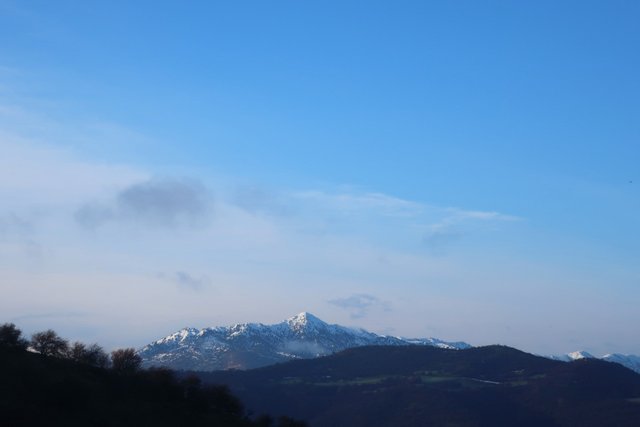
Soaked and saturated with water, the earth began to melt in the rays of the sun and dirt began to grow under the soles of our boots. We walked a little more and met a shepherd grazing sheep. He looked at us with curiosity and said that there was a stream ahead, which had overflowed heavily from the melting snows and we would not be able to cross it. And it would be better to turn back.

Ha-ha! He seems to have mistaken us for city puffies! We crossed such more hard obstacles. Moreover, the organizers warned about crossing the water barrier and we (well, me and several experienced guys who read the organizers' instructions very carefully) had spare shoes for such an event. However, not all...
Encouraging each other and slipping on the muddy path, we reached the stream.

And then I thought that the shepherd was not so wrong. The brook turned into a fairly wide and stormy river. We had two options - to complete the hike at the very beginning, or to cross the seething stream.
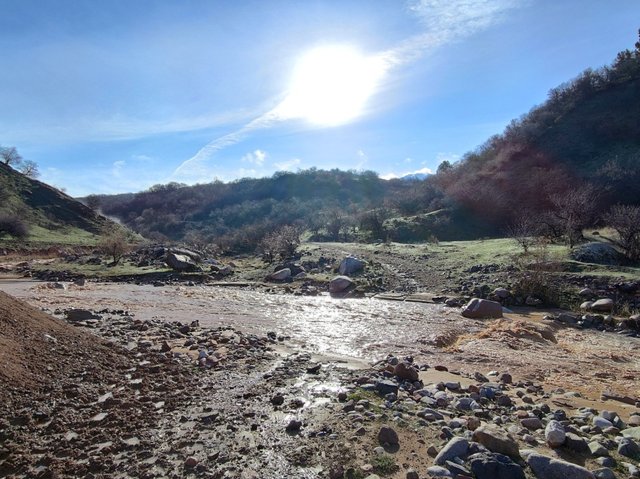
Without giving time to think, our guide took off his shoes and crossed the river. Seeing that he is alive and well. And also that he is on the other side of river and not planning to return. In addition, he didn’t get frostbitten on his feet and was not carried away by the stormy stream. In general, we threw away fear, taking off our shoes, went into the water too.



Having crossed the river and dried up, we went on. Then we walked for a couple of hours along unremarkable hills. They were kneading the mud along a muddy path and suddenly I saw an obelisk - I came closer and read the names of local residents who had not returned from the World War II. Wow, the war left its mark even in this wilderness, thousands and thousands of kilometers from the front ... What was especially pleasing - the obelisk, apparently, was built (or renovated) in 1999 and the place here is quite well-groomed. So they still remember!

We continued to move on. Clouds then ran over, threatening to turn into clouds, then they parted again revealing the sun.
The higher we climbed, the thicker the clay became. Adding to the boots in heavy lumps, it greatly slowed down our progress. It had to make great efforts to simply pull leg out of its tenacious paws.


This is how our boots looked after crossing a particularly difficult area.

We walked around another hill and came to the ridge on which Mount Kokbet is located. I was here in winter and climbed to its snowy summit. If the guide hadn't pointed his finger at the mountain, I would never have recognized these places. How everything changes at different times of the year! Just unbelieveble!

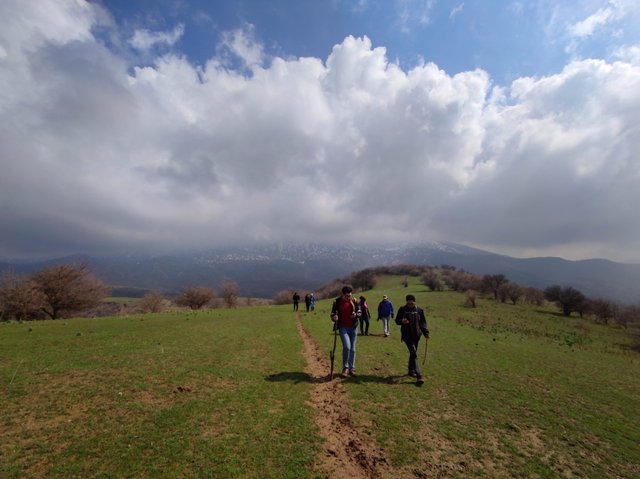
We walked along the path and I saw a whole field of snowdrops. Carefully, so as not to trample them, we went around the clearing and went on.

Climbing the hill, I saw a great canyon. Somehow it reminded me of the canyons of my beloved Boysun. Or rather, the Red Canyon. And so I wanted to go to Surkhandarya again, to eat delicious pilaf in the hospitable house of Choraka, to wander through the incredible Boysun mountains and rocks. Spoiler alert - after a week I succeeded :).

In the meantime, we looked at this canyon with delight. We probably spent a quarter of an hour here before moving on.

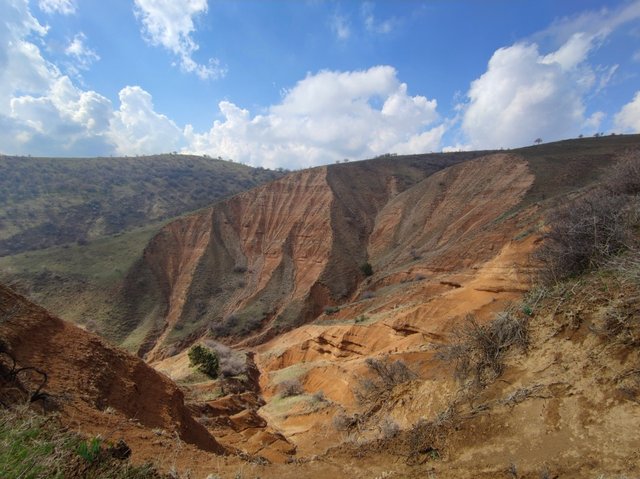
After passing the canyon, we began to go down the slopes of the hills.


And we started descending either to the village of Gidzhal, or to the village of Shuldak - they are located nearby and I always confuse them.
From one of the hills, we again saw Syurenata, and under it our tiny bus.

We went down to the village. The local kids looked at us with curiosity, not forgetting to politely greet us. In villages and old urban areas, the tradition of greeting elders is still preserved, even if you see them for the first time and in passing.


In the village we walked along improvised paving stones. For some reason, it reminded me of films about Japan - there the locals also moved along a similar path made of stones.


After about ten minutes we went down to the Aksagata river, near which a car was waiting. The driver's eyes went up to his forehead when he saw us smeared in clay. Apparently he imagined the bill for the car wash :).



We reassured him, saying that we would not get into the car in this form, but that we would first wash off in the river. After washing away all the dirt and, to the great relief of the driver, putting on spare clean shoes, we plunged into the car and headed back.
On the way back, the sunset was just as beautiful as the sunrise.
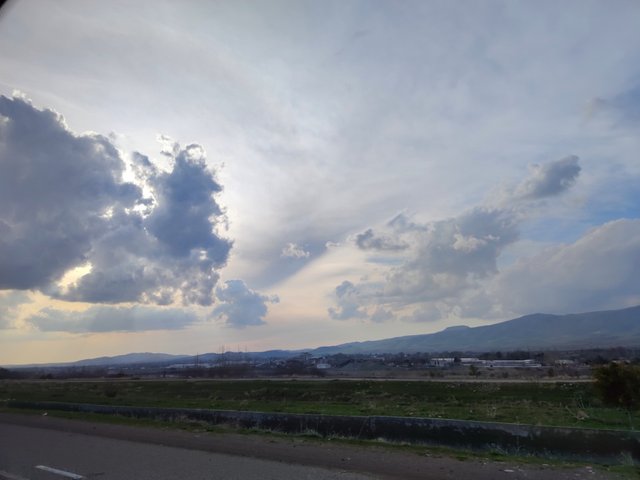
The next day I had a trip to Lake Tuzkan and a walk along the Pistalitau ridge. Well, a week later, dear to my heart Boysun was waiting for me. Another spoiler - I thought this trip was dirty, but Boysun convinced me that I was very wrong. It was both terrible and wonderful hike (though still more wonderful than terrible). But more on that in my next posts :).
Congratulations @damm-steemit! You received the biggest smile and some love from TravelFeed! Keep up the amazing blog. 😍 Your post was also chosen as top pick of the day and is now featured on the TravelFeed.io front page.
Thanks for using TravelFeed!
@smeralda (TravelFeed team)
PS: You can now search for your travels on-the-go with our Android App. Download it on Google Play